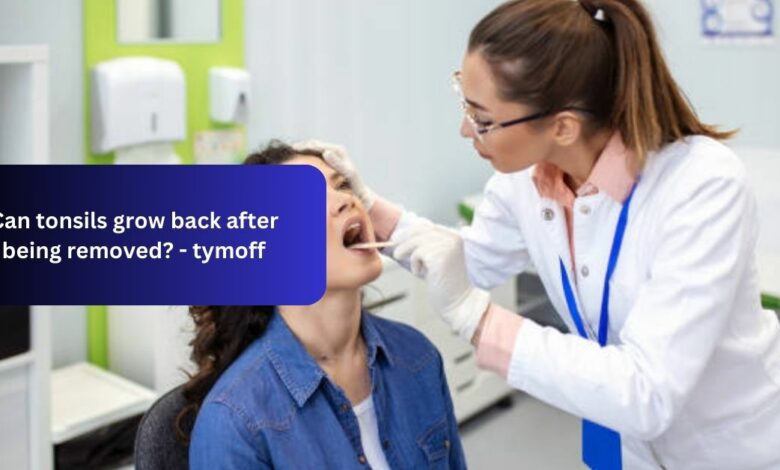Can tonsils grow back after being removed? – tymoff

Tonsillectomy, the surgical removal of the tonsils, is a common procedure performed for various medical reasons.
However, a question that often arises is whether tonsils can grow back after being removed. Understanding the potential for tonsil regrowth, its implications, and related medical insights can help patients make informed decisions about their health.
This article delves into the topic comprehensively, exploring the can tonsils grow back after being removed? – tymoff, reasons for tonsillectomy, the phenomenon of tonsil regrowth, and much more.
What Are Tonsils? Anatomy of Tonsils!
The tonsils are two oval-shaped masses of lymphoid tissue located at the back of the throat.
They play a crucial role in the body’s immune system by acting as sentinels to intercept and combat pathogens that enter the body through the mouth and nose.
Despite their protective function, tonsils can become inflamed, enlarged, or infected, leading to recurrent bouts of tonsillitis or obstructive sleep apnea.
Understanding Tonsillectomy:
Tonsillectomy, derived from the Latin word “tonsilla” meaning “almond,” involves the surgical removal of one or both tonsils.
Historically, this procedure dates back to ancient times, with early accounts of tonsil removal documented as far back as the 1st century AD.
Over time, advancements in medical science and surgical techniques have refined the procedure, making it safer and more effective.
3 Types of Tonsils – Understanding Their Roles and Locations!
The human body has three types of tonsils, each located in different areas and serving specific functions in the immune system:
- Palatine Tonsils: These are the most commonly known tonsils, located on either side of the throat. They are visible when you open your mouth wide and play a key role in intercepting airborne pathogens.
- Adenoids: Situated higher up, behind the nose, adenoids are not visible through the mouth. They are particularly active in young children and help filter out bacteria and viruses inhaled through the nasal passages.
- Lingual Tonsils: Found at the base of the tongue, these tonsils are part of the lymphatic tissue that helps protect the body from infections by trapping pathogens entering through the mouth.
Functions of Tonsils: Key Roles in Immune Defense
Tonsils play a critical role in the body’s immune system by performing two main functions:
- Immune Response: Tonsils are integral in producing antibodies, which are crucial for fighting infections. They help identify and neutralize pathogens such as bacteria and viruses that enter the body.
- Barrier Protection: Acting as the first line of defense, tonsils capture and combat pathogens inhaled or ingested through the mouth and nose. This barrier function prevents many infections from progressing further into the body.
Understanding these functions highlights the importance of tonsils in maintaining immune health. If you have persistent throat issues or recurrent infections, it’s essential to consult with a healthcare professional for proper evaluation and treatment.
Reasons for Tonsillectomy: When Removal Becomes Necessary
Tonsillectomy, the removal of tonsils, is sometimes necessary for better health. Here’s why your doctor might suggest it:
- Frequent Infections: If you often get tonsillitis or strep throat, it can be really tough to deal with. Removing your tonsils can help reduce these frequent infections and make you feel better overall.
- Sleep Issues: Enlarged tonsils can block your airway and cause sleep apnea, leading to poor sleep and health problems. Tonsillectomy can open up your airway, helping you breathe easier and sleep better.
If you’re struggling with constant throat infections or sleep problems, talk to your doctor. They can help you decide if a tonsillectomy is the right choice for you.
Other Medical Conditions:
Chronic tonsillitis, abscesses, and difficulty swallowing due to enlarged tonsils are other reasons for removal.
Can tonsils grow back after being removed? – tymoff – Understanding the Possibilities
After undergoing a tonsillectomy, patients may wonder if their tonsils can grow back. While it’s not common, in some cases, tonsils can partially regrow after removal. This phenomenon is more likely if some tonsil tissue remains after the surgery.
The mechanism behind tonsil regrowth involves the residual tissue left behind during the initial procedure.
If even a small amount of tonsil tissue remains, it has the potential to regenerate over time. Additionally, factors such as lymphoid hyperplasia, where the remaining lymphoid tissue proliferates in response to infections or inflammation, can contribute to regrowth.
It’s essential for patients who have undergone tonsillectomy to be aware of the possibility of regrowth, albeit rare.
Any symptoms suggestive of tonsil regrowth, such as recurrent sore throats or difficulty swallowing, should prompt a visit to the doctor for evaluation.
Early detection and appropriate management can help address any potential issues related to tonsil regrowth effectively.
Understanding the Mechanism of Tonsil Regrowth – What You Need to Know
Tonsil regrowth, though rare, occurs through specific mechanisms:
- Residual Tissue: Even if a small amount of tonsil tissue is left behind after surgery, it can potentially regenerate over time. This residual tissue serves as a foundation for regrowth, leading to a recurrence of tonsil tissue.
- Lymphoid Hyperplasia: In some cases, the remaining lymphoid tissue may undergo hyperplasia, a condition where it proliferates in response to infections or inflammation. This increased growth of lymphoid tissue can contribute to the regrowth of tonsils.
Despite the potential for regrowth, it’s important to note that tonsil regrowth is relatively uncommon, affecting only a small percentage of patients. The extent of regrowth can vary from minimal to significant, with symptoms ranging from mild to severe. Regular follow-ups with healthcare providers are essential for monitoring any signs of regrowth and ensuring timely intervention if necessary.
Identifying Symptoms and Signs of Tonsil Regrowth
Recognizing the indications of tonsil regrowth is crucial for timely intervention and management:
Common Symptoms:
- Sore Throat: Persistent or recurring sore throats can signal the presence of regrown tonsil tissue, especially if accompanied by other symptoms.
- Swelling: Visible or palpable swelling in the throat may indicate regrowth and should prompt further evaluation by a healthcare provider.
- Infection: Frequent throat infections resembling pre-tonsillectomy symptoms, such as pain, redness, and difficulty swallowing, may indicate regrowth of tonsils.
Uncommon Symptoms:
- Difficulty Swallowing: Significant regrowth can lead to difficulty swallowing, which may manifest as discomfort or a sensation of food getting stuck in the throat.
- Obstructive Symptoms: Breathing difficulties, particularly during sleep, can occur if regrown tonsils obstruct the airway, leading to sleep disturbances and fatigue.
If you experience any of these symptoms, especially if they persist or worsen over time, consult a healthcare professional for proper evaluation and management. Early detection of tonsil regrowth allows for timely intervention and improved outcomes.
Exploring Causes and Risk Factors of Tonsil Regrowth
Understanding the factors that influence tonsil regrowth can help individuals make informed choices about their health:
Biological Factors:
- Incomplete Removal: When tonsils are only partially removed, residual tissue left behind can trigger regrowth, highlighting the importance of thorough surgical procedures.
- Age: Younger patients are more prone to tonsil regrowth, possibly due to faster tissue regeneration and immune system activity.
Environmental Factors:
- Infections: Recurrent infections can stimulate the regrowth of lymphoid tissue, emphasizing the need for infection prevention strategies.
- Inflammation: Chronic inflammation in the throat area can contribute to regrowth, underscoring the importance of managing inflammation effectively.
Lifestyle Factors:
- Poor Hygiene: Inadequate oral hygiene increases the risk of infections, potentially leading to regrowth. Maintaining good oral health habits is essential for reducing this risk.
- Smoking: Smoking not only exacerbates throat inflammation but also compromises the immune system, increasing susceptibility to infections and regrowth.
By addressing these factors proactively, individuals can mitigate the risk of tonsil regrowth and promote better post-surgery outcomes. Regular dental care, smoking cessation, and infection prevention measures can play a significant role in minimizing the likelihood of regrowth.
Navigating Diagnosis and Treatment Options for Tonsil Regrowth
Discover the steps involved in diagnosing tonsil regrowth and explore the various treatment options available:
Diagnosis and Tests:
- Physical Examination: A comprehensive evaluation of the throat is conducted to identify any signs of regrowth, such as swelling or redness.
- Imaging Tests: Ultrasound, MRI, or CT scans provide detailed images of the throat, aiding in the detection of regrown tissue.
- Laboratory Tests: Throat swabs and blood tests are performed to check for infections and assess overall immune function.
Treatment Options:
- Medical Treatments: Antibiotics are prescribed to treat recurrent infections, while anti-inflammatory medications help alleviate inflammation and swelling.
- Surgical Options: Revision tonsillectomy involves removing regrown tissue through a secondary surgery. Laser tonsillectomy offers a less invasive alternative using advanced laser technology.
- Lifestyle Adjustments: Maintaining good oral hygiene, adopting a healthy diet rich in immune-boosting nutrients, and making lifestyle changes can help prevent infections and promote overall well-being.
By undergoing appropriate diagnostic tests and considering tailored treatment approaches, individuals can effectively manage tonsil regrowth and improve their quality of life.
Proactive Steps to Prevent Tonsil Regrowth
Implementing preventive measures can significantly reduce the risk of tonsil regrowth and promote overall throat health:
Good Oral Hygiene:
Maintain a consistent routine of regular brushing, flossing, and the use of antiseptic mouthwash. This helps eliminate bacteria and reduces the likelihood of infections that could lead to regrowth.
Healthy Lifestyle Choices:
- No Smoking: Avoiding smoking is crucial, as it can irritate the throat and contribute to inflammation, increasing the risk of regrowth.
- Regular Check-ups: Schedule periodic medical check-ups to monitor the health of your throat and detect any signs of regrowth early on.
Vaccinations:
Stay up-to-date on vaccinations to prevent infections that could trigger tonsil regrowth. Vaccines protect against common pathogens, reducing the risk of recurrent infections and subsequent regrowth.
By incorporating these preventive measures into your daily routine and healthcare regimen, you can minimize the likelihood of tonsil regrowth and maintain optimal throat health.
Personal Stories or Case Studies
Case Study 1: Emily’s Experience
Emily underwent a tonsillectomy at age 10 due to recurrent tonsillitis. At age 15, she began experiencing sore throats again. Upon examination, her doctor discovered partial tonsil regrowth, which was managed with medication and lifestyle changes.
Case Study 2: Michael’s Journey
Michael had his tonsils removed at age 7 to treat sleep apnea. By age 12, his sleep apnea symptoms returned. A follow-up surgery revealed significant regrowth, and he underwent a revision tonsillectomy.
Expert Insights:
Dr. John Smith, ENT Specialist
“Tonsil regrowth, while uncommon, is a possibility that patients should be aware of. It’s important to follow up with your doctor if symptoms return post-tonsillectomy.”
Dr. Lisa Jones, Pediatrician
“Parents should monitor their children for signs of regrowth, especially if they had a tonsillectomy at a young age. Early detection can lead to more effective management.”
Conclusion About Can tonsils grow back after being removed? – tymoff –
“Can tonsils grow back after being removed? – tymoff ” though rare, is a condition that requires awareness and timely medical intervention. Understanding the reasons, symptoms, and treatment options can help patients and caregivers manage this condition effectively. Regular follow-ups and maintaining a healthy lifestyle are crucial in preventing complications related to tonsil regrowth.
FAQ’s:
1. Can tonsils grow back after being removed completely?
While it’s rare, there have been cases where tonsils partially regrow after complete removal. This is more likely if some tissue remains post-surgery.
2. What are the signs that tonsils may be regrowing after removal?
Common signs include persistent sore throat, swelling in the throat, and frequent infections similar to pre-tonsillectomy symptoms. Difficulty swallowing and breathing difficulties, particularly during sleep, are less common but possible signs.
3. What factors contribute to tonsil regrowth?
Factors such as incomplete removal of tonsil tissue, young age at the time of surgery, recurrent infections, chronic inflammation in the throat area, poor oral hygiene, and smoking can increase the risk of tonsil regrowth.
4. How is tonsil regrowth diagnosed?
Diagnosis involves a thorough physical examination of the throat, imaging tests such as ultrasound or MRI/CT scans, and laboratory tests including throat swabs and blood tests to check for infections and assess overall immune response.
5. Can anything be done to prevent tonsil regrowth after removal?
While regrowth cannot always be prevented, maintaining good oral hygiene, avoiding smoking, staying up-to-date on vaccinations, and scheduling regular check-ups with a healthcare provider can help reduce the risk of tonsil regrowth.

